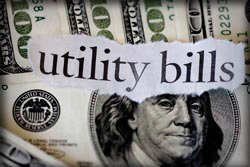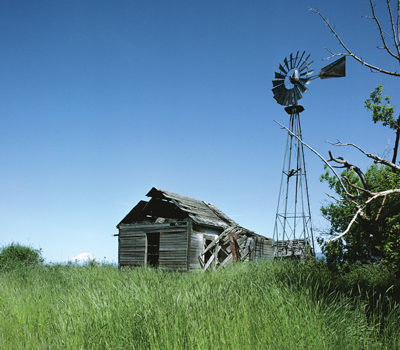WHAT CAP AND TRADE WILL DO TO SMALL BUSINESS
![]()

Shock to the System
Look at your electricity bill from last month. Now add 40%. That’s what an energy cap and trade proposal could mean to your small business. NFIB explains what environmentalists and big government loving lawmakers don’t want you to know about it.
Douglass Henry was green long before it was trendy. For more than 46 years his business, Henry Molded Products, has created packaging out of recycled fiber. "The hallmark of our company is to create sustainable products," says the president and CEO of the Lebanon, Pa. based business. "Being environmentally friendly is a core value in our mission."
Always on the forefront of sustainable practices, Henry Molded Products took a leap last year and installed new machinery and equipment to help conserve natural gas. Even though they’ve been pleased with the improved efficiency and increased productivity the system was costly, and in this economy, the costs haven’t yet been recouped.
None of that would be so bad if it weren’t for the rumblings Henry hears out of Washington, D.C. Talks are under way now between the administration and congressional leaders to establish an energy policy plan that would result in enormous hidden taxes on energy costs. If passed, these plans could boost Henry’s annual energy bill by as much as $400,000.
Even though he has made efforts on his own to reduce his energy consumption, Henry and millions of other small business owners across the country would face higher utility costs, up to 40 percent higher by some estimates. Energy costs are already a major concern to small business owners who ranked them as the second most severe problem related to running a business in NFIB’s 2008 Problems and Priorities survey.
"What drives energy use—and what should drive energy policy—is fundamental and sound economics," Henry says. "If the price of energy goes up,then we need to be inspired to be more
efficient and frugal with our energy use. If the government wants to help, encouraging conservation by offering investment tax credits for energy efficient equipment would be a lot more
productive than issuing penalties."
What cap and trade means for small business
Cap and trade systems are basically a trading of pollution credits. Overall air quality goals are set for a certain area, and facilities that emit air pollution are given a certain number of allowances. If a facility falls below its allowable pollution levels it can sell its remaining credits to others. Facilities that buy the leftover credits can then pollute more because the sellers are polluting less.
The goal of a cap and trade system is to regulate and reduce greenhouse gas emissions such as carbon dioxide, methane and nitrous oxide. Under Congress’ proposal, businesses that emit greenhouse gases would be required to purchase government credits to offset their emissions.
"Virtually all businesses emit at least some greenhouse gases," says NFIB President and CEO Dan Danner. "But under a cap and trade system no small business is safe from higher costs—even ones that don’t emit very much."
While low emitting businesses might be exempt from buying government credits, they will still pay indirectly. Utility providers, which emit large quantities of greenhouse gases, will be saddled with exorbitant fees which will then be passed on to consumers in the form of higher energy costs for both individuals and small businesses.
"The cap and trade system is being called a tax because it’s simply a way for the federal government to raise revenue to pay for new government run programs," Danner says. "The environmentalists get massive regulation of emissions, and politicians get bagfuls of tax money to spend.
"But no one is considering what will happen to America’s job creators. At a time when our nation faces near 10 percent unemployment and stalled economic growth, now is not the time to impose an $846 billion energy tax on small business."
What it would cost
The projected costs of the cap and trade program are overwhelming. According to recent analysis by the nonpartisan Congressional Budget Office and Joint Committee on Taxation, current pending legislation would cost about $821 billion and raise $846 billion over the next 10 years, giving Washington politicians an additional $25 billion more in taxpayer dollars to waste.
During the 110th Congress the Congressional Budget Office estimated that a less aggressive cap and trade bill would have raised $1.2 trillion in new revenue.
"Regardless of whose figures are most accurate it’s obvious that the administration views this as a prime opportunity to generate enormous amounts of revenue," Danner says. "The most ridiculous part of the proposal is that money raised does nothing to help the environment. Instead, Congress wants to use the billions of dollars to fund a new government provided healthcare program and to expand existing entitlement programs."
Big businesses, such as public utility companies and large scale manufacturers, will initially pay for the program, but will pass the cost on to small businesses and consumers by raising prices and cutting jobs. The current cap and trade proposal could result in about 1 million job losses each year according to an analysis by the Tax Foundation.
NFIB expects that a cap and trade bill would include credits for some large companies,which might delay cost increases for the first few years of the program. "But the end result will be the same," Danner says. "Issuing a grace period for some companies might be the only way to get the bill passed. And though the credits may delay the price hikes they will come eventually—and they will cost hundreds of thousands of small business jobs."
Even President Obama has acknowledged that his plan will hurt consumers. In a January 2008 interview with the San Francisco Chronicle, Obama admitted that "under my plan of a cap and trade system electricity rates would necessarily skyrocket."
How much they would skyrocket depends on where you live, but the average family is expected to see a minimum annual increase of $1,300 in their energy related bills according to a Congressional Budget Office report. Small business owners will be hit twice with rates increasing both at the office and at home.
 |
| Economic Implications of EPA’s Proposed Ozone Standard |
How it would affect the economy
John Nicholson isn’t sure how his small flower shop would absorb the higher costs. "We consume roughly three times as much energy as the normal household, so that means we are probably going to face an added $20,000 or more a year, and none of that extra expense is going to increase our sales or develop more profit," says Nicholson, owner of Arlington, Va.-based Company Flowers. "Most likely we’ll have to pass the added costs along to consumers in the form of higher prices." Like Douglass Henry of Henry Molded Products, Nicholson’s business has been trying to conserve energy on its own, not because of government mandates, but because "it’s the right thing to do," Nicholson says.
Company Flowers has nowhere near the utility expenses of Henry’s large manufacturing facilities, but Nicholson’s small conservation steps have made a difference. "We’ve switched to lower wattage spotlights; we turn off electrical appliances at night; and we’ve been less vigorous with our air-conditioning," says Nicholson who also offers customers "green" flower and giftware options. "Small steps maybe, but they all add up."
What doesn’t add up is how cap and trade supporters expect consumers to afford higher energy costs in a slow economy. "It doesn’t make sense to be trading for new taxes on energy when it’s already becoming more expensive," says Henry who lives in a state where residents now face double digit energy price increases because of deregulation.
"Cap and trade would clip our ability to grow and continue to serve new markets, develop new products and create new jobs," he says. "All investments to conserve energy would be zapped by the cap and trade system."
Instead of taxing companies into conservation Henry prefers the government offer credits and grants to businesses for installing energy efficient equipment. His company, he says, could greatly benefit from additional energy conservation projects that he just can’t afford on his own right now.
"These projects would enable us to go after new business, create jobs and conserve more energy," he says. "It would be a great example of government funding that didn’t go toward the financial or automotive industries but to independent businesses that could actually benefit from it."
Where it stands
Currently the cap and trade proposal faces serious opposition from some moderate Democrats and most Republicans. In June, the American Clean Energy and Security Act of 2009 (H.R. 2454) narrowly passed the U.S. House 219–212.
NFIB sent a letter to representatives strongly encouraging them to vote against the bill and key voted "No" on final passage. To address the immediate energy needs of small business, NFIB supports increased domestic and offshore drilling for oil and natural gas as well as the expanded use of nuclear power. Unfortunately, none of those provisions are included in the bill that passed the House. NFIB will continue to urge the Senate to oppose the House passed bill.
"This proposal is a perfect example of the little guys getting nothing," Danner says. "Large companies will get the early credits then they’ll raise their prices. Our members, who can’t pass on their costs, will get stuck holding the bag for a program that costs a lot of money."

A Hit to the Heartland
These states are the top 10 greenhouse gas producers according to World Resources International. If cap and trade is passed residents in these states could be the first ones to see dramatic hikes in their utility costs: